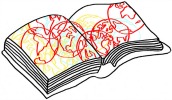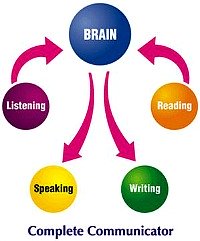 |
Learn English Locally, Apply It Worldwide! Enjoy Regular Practice |
The Image as a Writing Device
To the writer the image is a device – in fact the most powerful and important device available to the wordsmith artist, no matter what language one writes in, or what one wants to express on paper.
We have seen previously that the world enters our system by way of our five senses. Therefore in our attempt to share the world we perceive with other people, a writer will need to express something in language that is comprehensible to one or more of the five senses, for the readers to be able to register what is conveyed by the image.
For the purpose of our lesson, we shall give ‘the image’ a slightly wider meaning than just that of a visual image. An author can conjure an immediate impression of sight, hearing, scent, touch or even taste. In this sense, we return to the concept of the writer being the sorcerer or the magician of the apparitions on the written pages.
Like a good chef, an author combines a selection of ingredients by using a magic formula, the result of which is imagery delivering or expressing different levels of meaning.
|
First, on an individual level: for example an individual cat, ‘that one’, quite unlike any other cat. |
“And Pepper, her own, her very own cat, had climbed up his coat, and now lay on his shoulder, purring feebly.” |
|
On the second level, the object of the image is a representative of its class/type of family, i.e. it is a member of that particular branch of mammals called ‘cats’ (a tiger and a tabby belong to the same family). On this level its attributes aren’t individual, but common to all cats. |
“He was typically a Persian cat, blue-haired and yellow-eyed, a creature of smoke and fire, of grey jade and topaz, who sits upon a wall and receives tribute daily, looking past his worshipers’ heads with subtle shining eyes like those of an idol staring over priests in an Eastern temple.” [Morley Roberts – “The Young Man Who Stroked Cats”] |
|
Thirdly, there is that magical, or universal identity from which the essence of the object of one’s writing originates. On this level the name carries the power of symbol; it embodies the original and constant essence of each and every cat. That is the catty or cat-like attributes belong to this level. |
“In the silence of the watching we heard something without mewing like a she-otter. We both rose to our feet, and, I answer for myself, not Strickland, felt sick – actually and physically sick. We told each other, as did the men in Pinafore, that it was the cat.” [Rudyard Kipling - "The Mark of the Beast"] |
To conclude our short lesson about the image, we must appreciate that the image is a writing device in every form of writing, not just in prose as we have seen above. It is necessary in writing from advertisements to poetry and epic. Of all of them, it is undoubtedly true that a poet will claim that his imagery is the most exact, the most intense and like laser-beams the most burningly focused.
In our future lessons we shall look into the types of image used by poets, including the direct descriptive image, the narrative image, the transforming image, the magic image, the fiery image, the arresting image. After that, we shall consider some figures of speech used in writing to help us construct the images we wish to deliver to our readers.
English Corner Weekly E-zine
Packed with knowledge, published on Tuesdays.
Get yours here!
Our Archives:
Our lessons in the names and sounds of letters, short & long vowel sounds, CVCs, CCVCs, CVCCs, sight words, vowel and consonant contrasts, etc.
Our lessons will help increase your vocabulary, word recognition, find meaning in context, skills for TOEFL tests and other games, for fun.
Here we shall build some lessons to help you improve your writing skills.
Lots of lessons: cause & effect, comparisons, linking signals, relative clauses, presenting information, expressing emotions and grammar games, of course. We had more lessons on: intensifying adverbs and phrasal verbs, expressing various concepts such as addition, exception, restriction and ambiguity. Lately we started some exercises: likes/dislikes, frequency adverbs (twice), verb tenses, etc.
Learn how to build a website, by using the SBI! system - start from the basics, developing a site concept and a niche, supply and demand, learn about profitability and monetization, payment processing, register domain, website structure and content as a pyramid. Also learn about the tools I'm using to build this website. We also covered how to build traffic, working with search engines, building a good system of inbound links, using social marketing and blogs with the SBI system, how to use Socialize It and Form Build It, how to publish an e-zine and how to build a social network in your niche.
We looked at a few games by now: Countable & uncountable nouns, Free Rice, Name That Thing, Spell It, Spelloween, the Phrasal Verbs Game, Preposition Desert, The Sentence Game, Word Confusion, Word Wangling, Buzzing Bees, and The Verb Viper Game.
Be prepared to play and learn more pretty soon.
